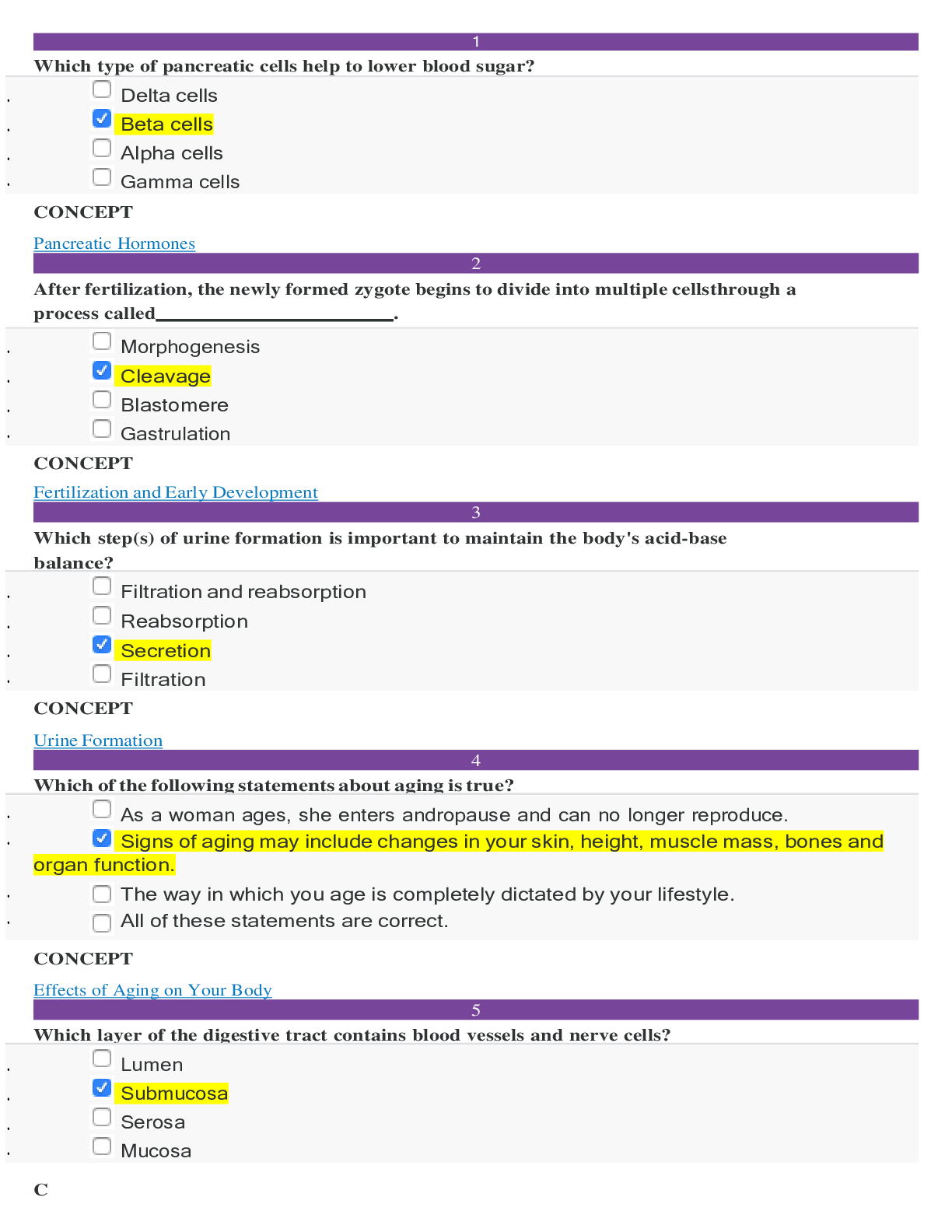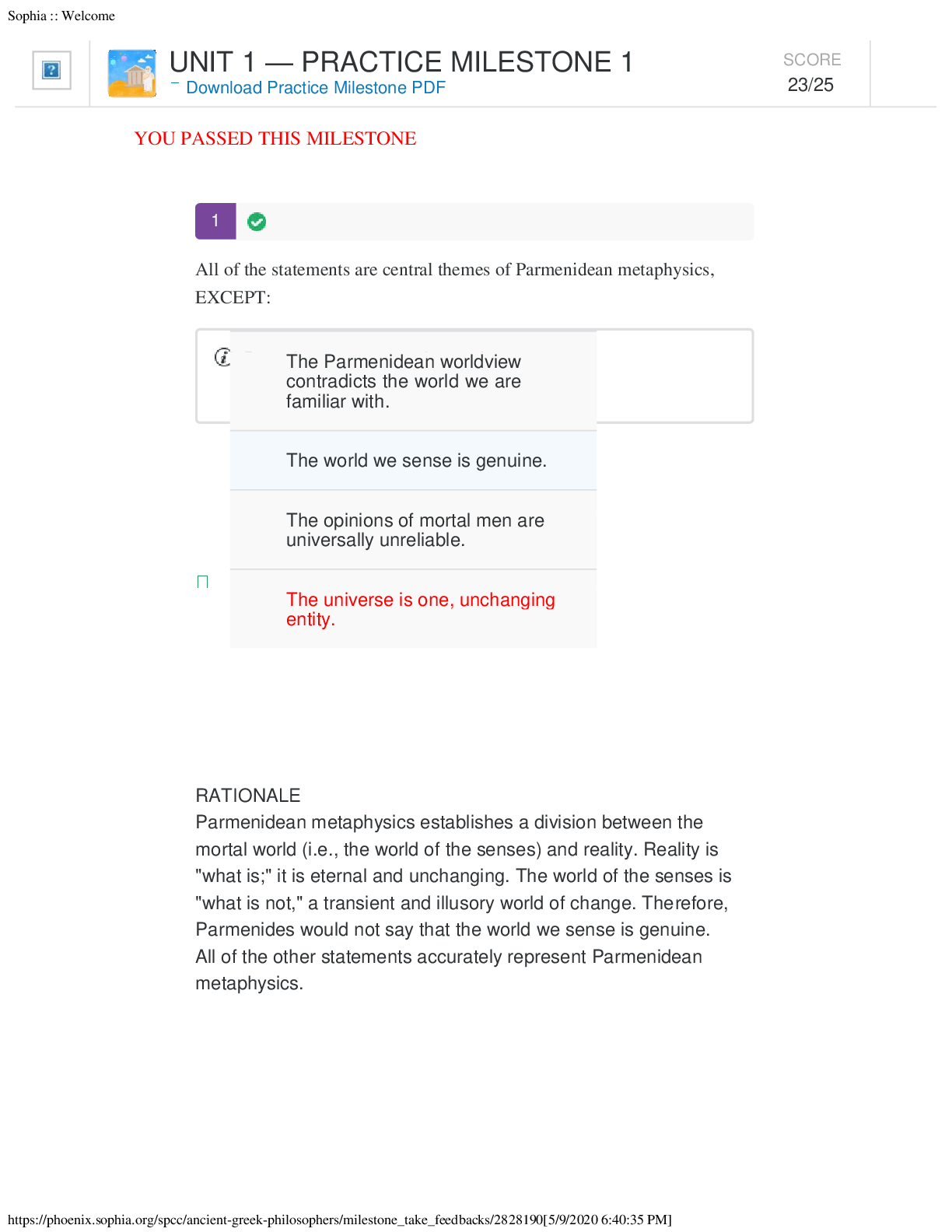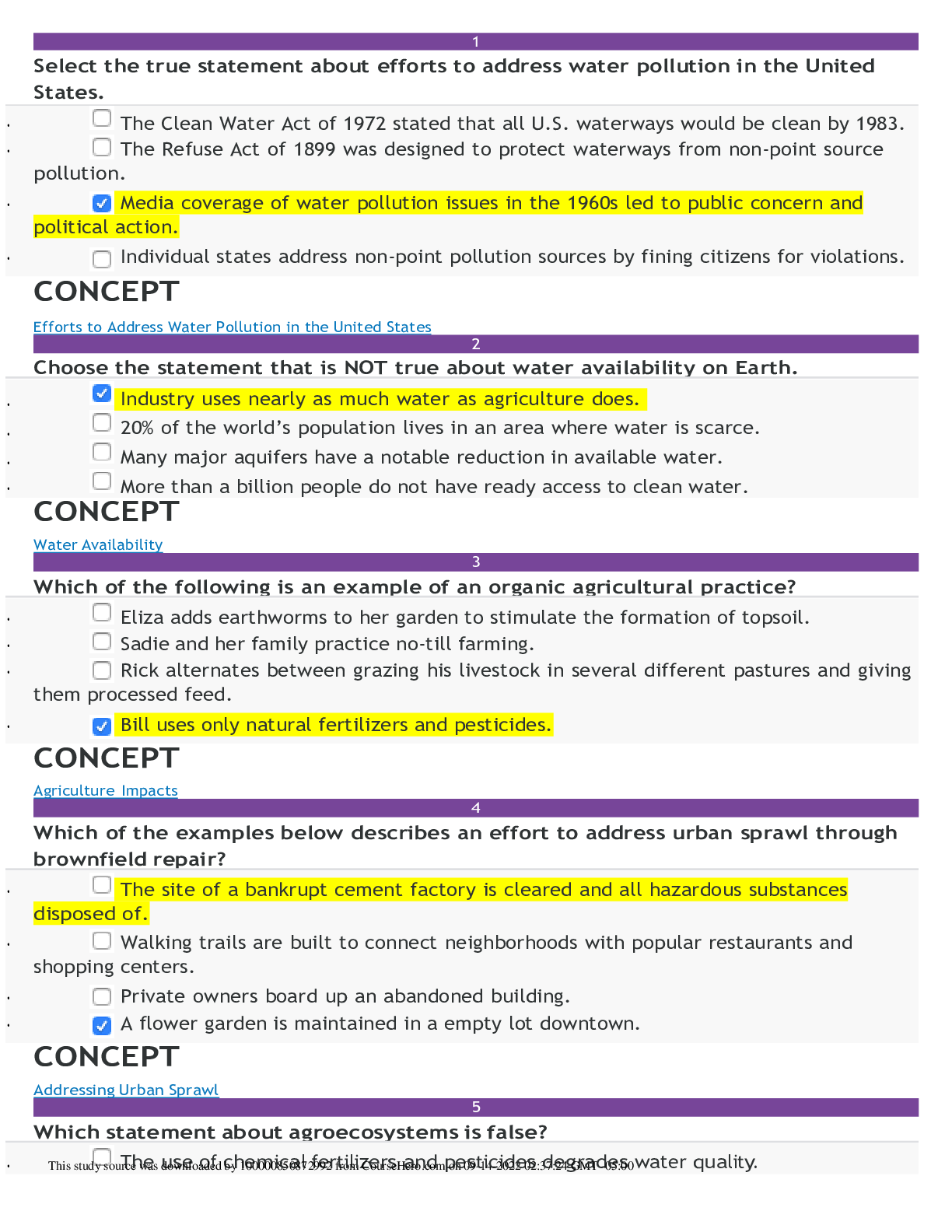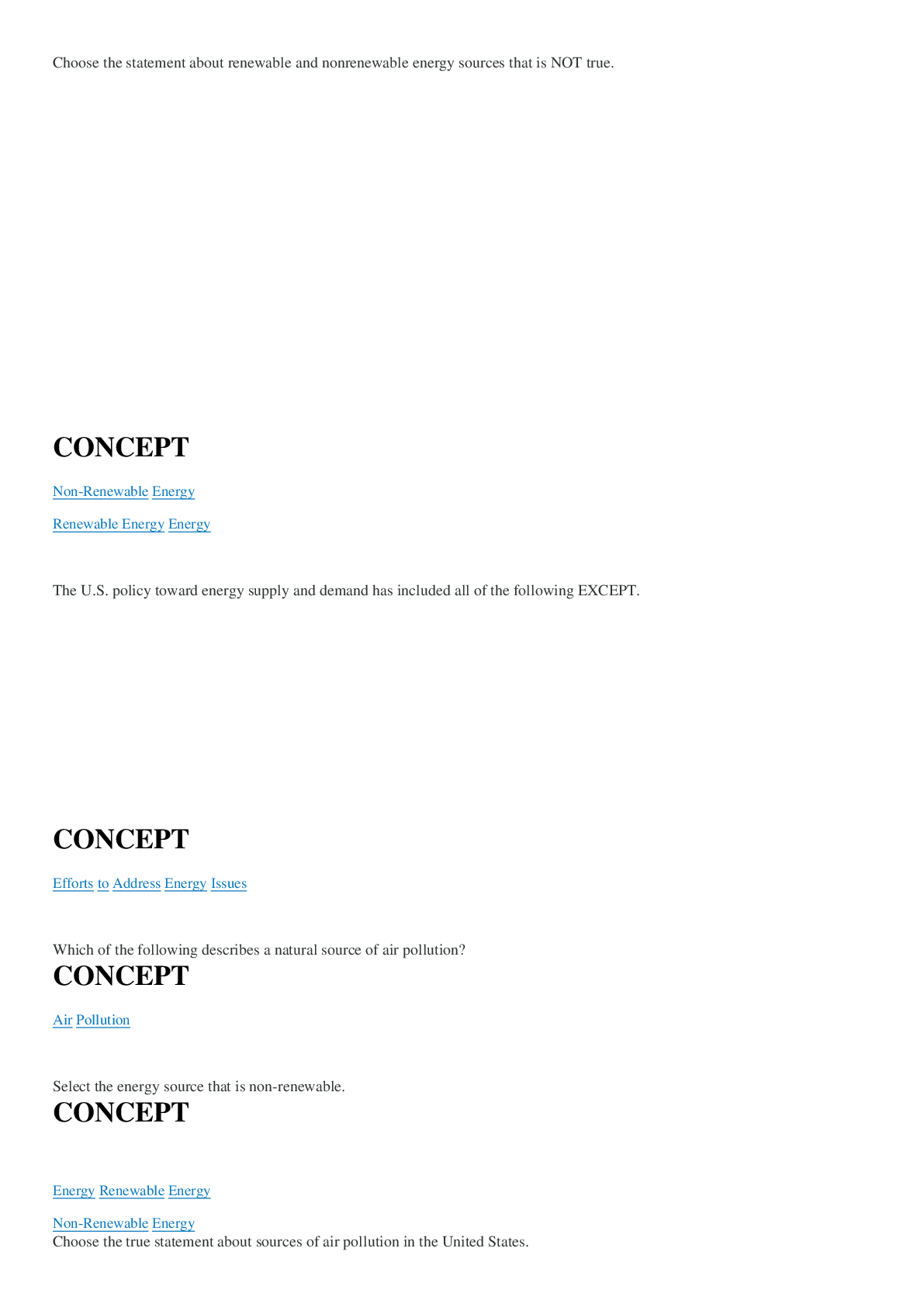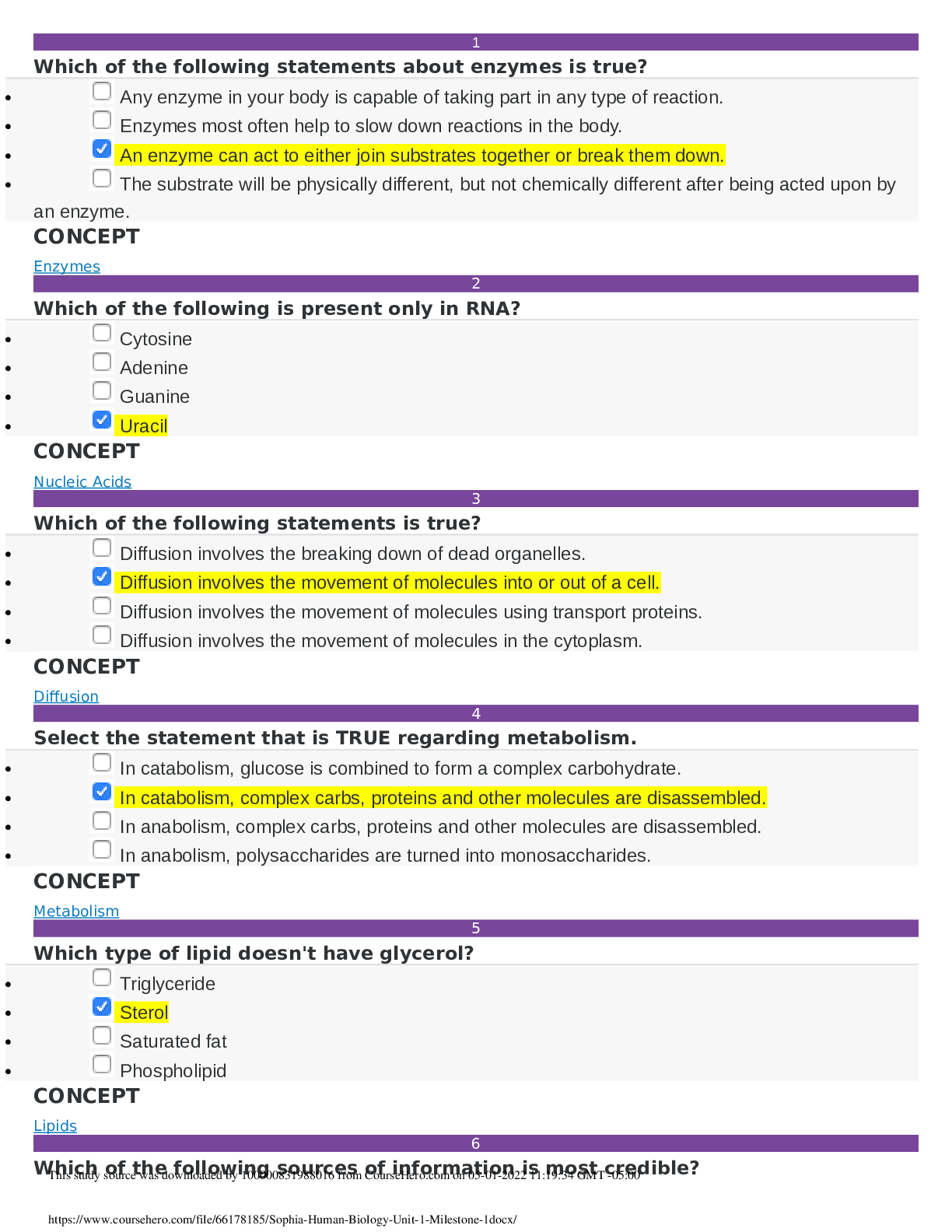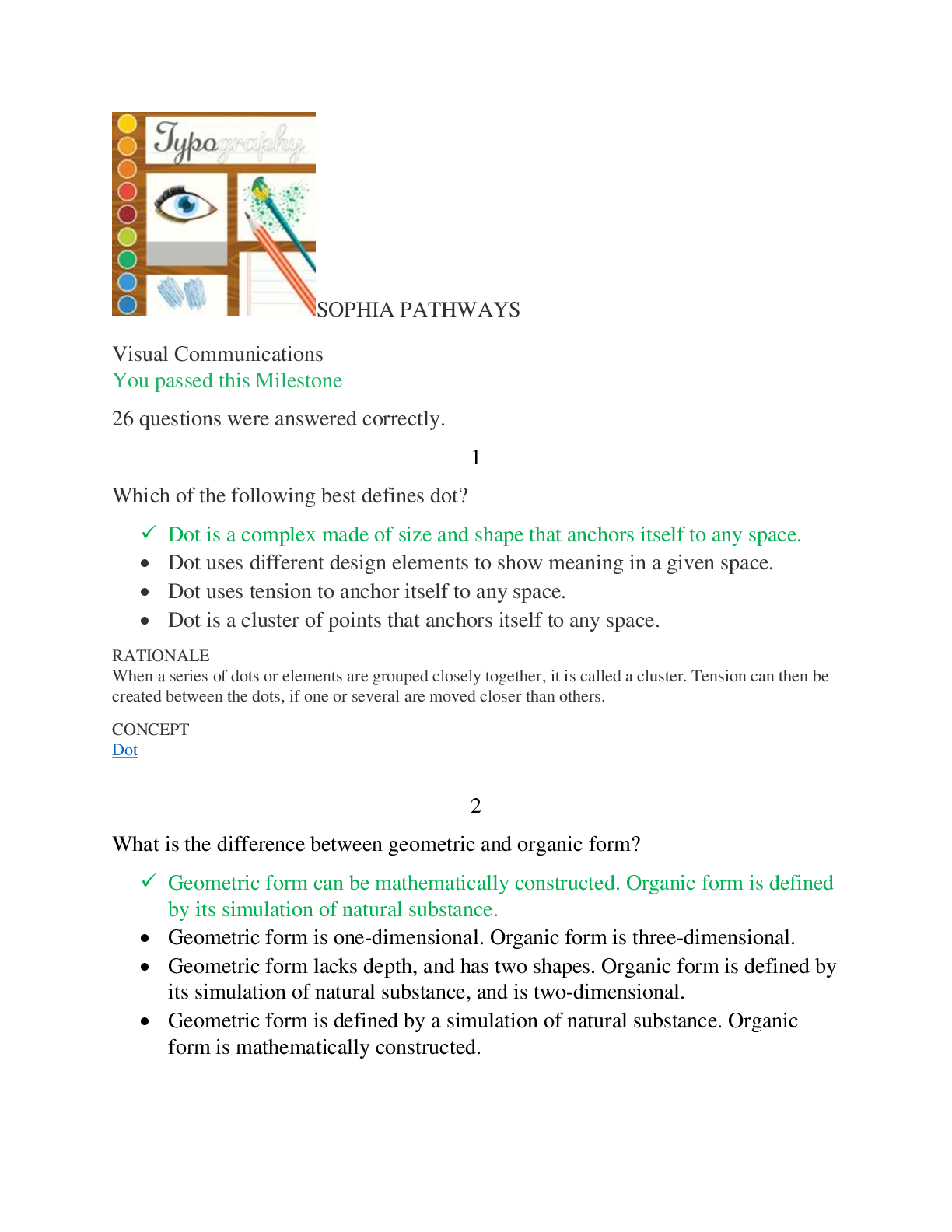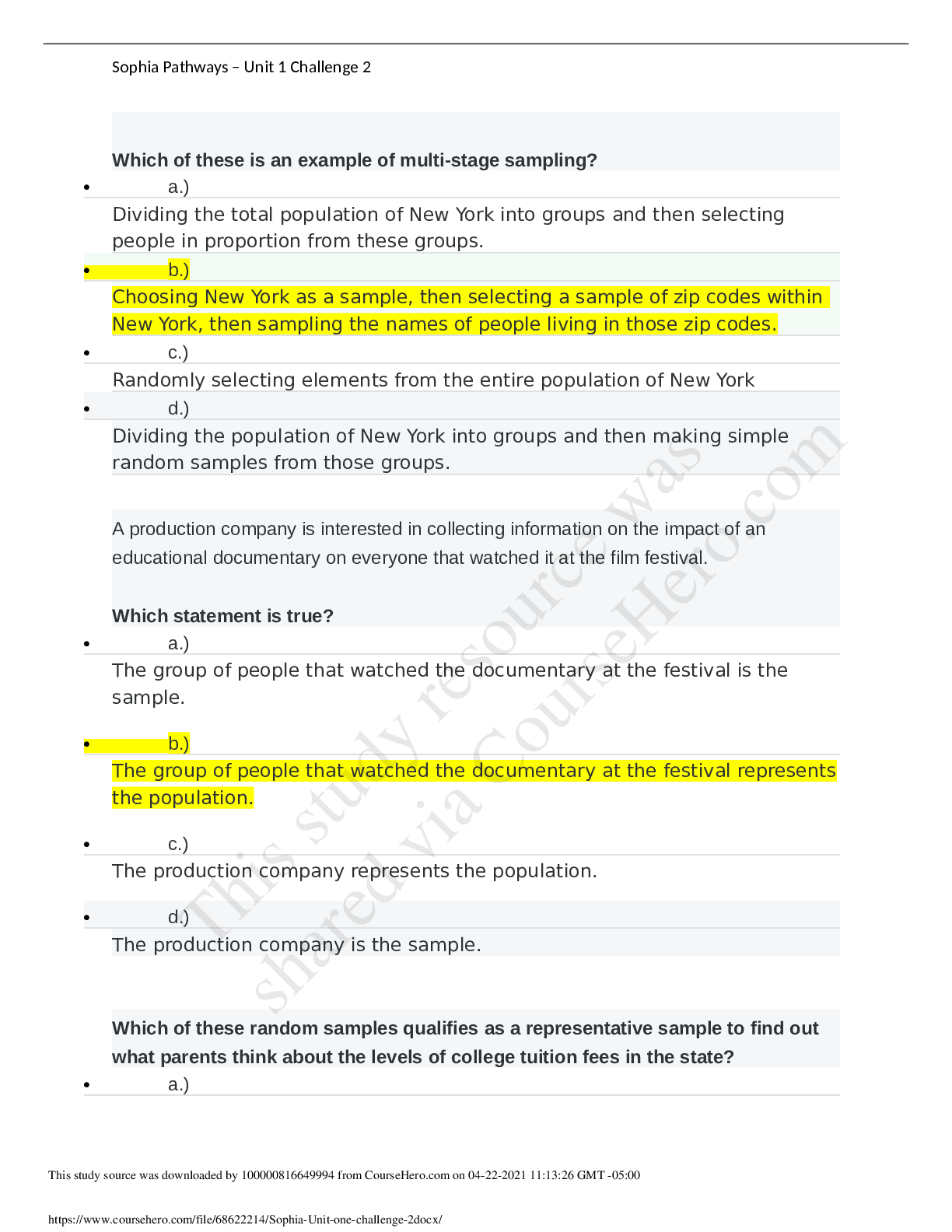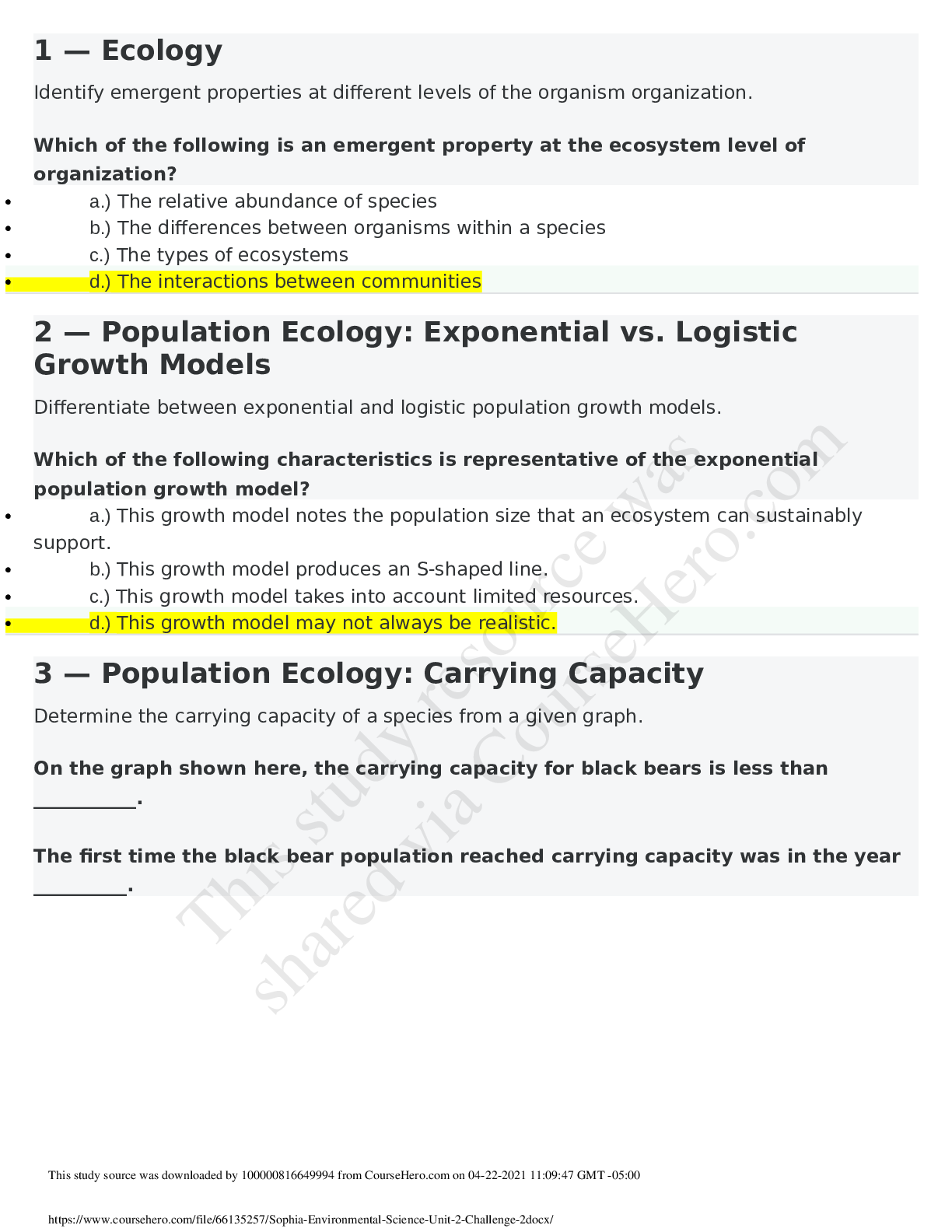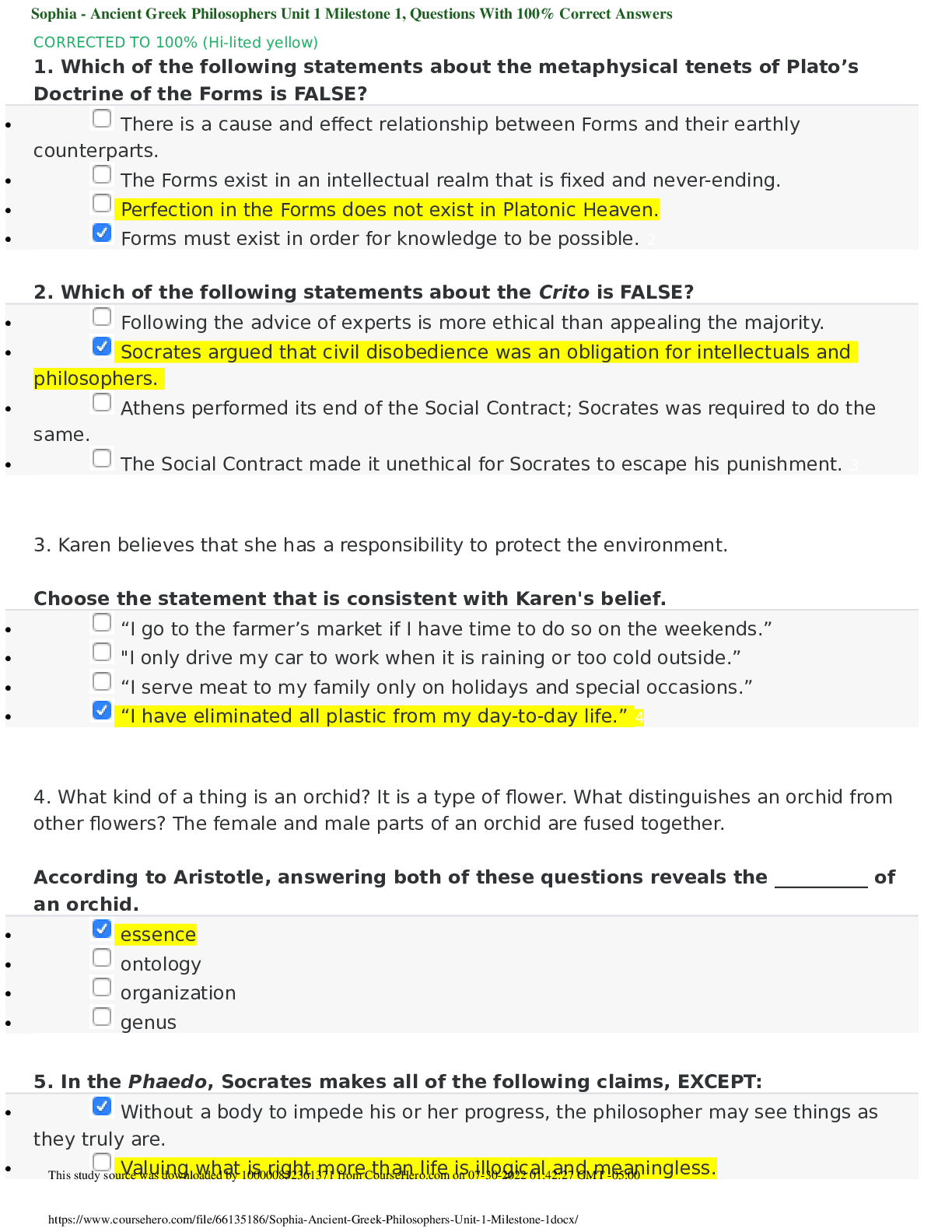Environmental Science > SOPHIA PATHWAY > SOPHIA PATHWAY Sophia - Environmental Science - Practice Unit 1 Milestone 1. CORRECT ANSWERS HIGHLIG (All)
SOPHIA PATHWAY Sophia - Environmental Science - Practice Unit 1 Milestone 1. CORRECT ANSWERS HIGHLIGHTED IN YELLOW.
Document Content and Description Below
Of the four graphs below, select the one that is misleading. ”Types of Weather in February” Pie Chart is the correct answer CONCEPT Graphs in Environmental Science 2 Plant and animal li... fe faced some challenges when moving from water to land. Identify which things from the list below were among the challenges faced during the early life transitions. Yes No More difficult to move on land X Finding an adequate food supply X A lack of ozone protection on land X CONCEPT Early Life 3 Select the month the solar system was created from the options below based on the one-year calendar model according to the Big Bang theory. • August • September • December • January CONCEPT Earth's Formation 4 Categorize the statements below as reflecting an environmental scientist stance or an environmentalist stance. Environmental Scientist Environmentalist Overfishing and land-based pollution have damaged 20% of the ocean's coral reefs. X Corals demonstrate the partnership of symbiosis in which both plants and animals benefit. X Approximately 30 million people around the world are dependent on reefs, and they must protect them. X CONCEPT Environmentalism 5 Classify the following examples according to the type of service they provide. Provisioning Regulating Cultural Pollination X Fresh Water X Recreation X CONCEPT Biodiversity 6 Pair each group below with the best example of how it might use environmental science. Scientists (B) Government Agency (C) Private Business (A) • A. To understand how environmental laws will impact decisions and processes • B. To try to understand the processes and systems that lead to environmental issues • C. To manage natural resources and address environmental issues • D. To gain knowledge and advocate for desirable actions CONCEPT Applying Environmental Science 7 Which of the following statements is true about projected population growth? • People in overpopulated regions will migrate in large numbers, causing environmental destruction as they travel. • If population growth continues, the population in 2030 will be 20 billion people. • If growth slows dramatically, the Earth's population in 2050 will be 7.4 billion people. • The consequences of overpopulation (i.e. hunger and disease) are inevitable for humans in the future. CONCEPT The Impact of Population Growth 8 Which of the following is likely to have led to the greatest number of mass extinctions? • Glacial melt • Earthquakes • Asteroids • Massive flooding CONCEPT Continental Drift and Major Extinctions 9 Pair each term below with its corresponding definition. Biodiversity (D) Ecosystems (C) Sustainability (A) • A. The practice of using resources without depleting them for future societies • B. Dependence of species upon one another • C. A biological community of living and non-living organisms and their environment • D. The variety of life existing in a specific region CONCEPT Biodiversity Sustainability 10 Correctly identify what event, agent or process of those given below is responsible for the current atmosphere on Earth of 20% oxygen. • Ozone layer formation • Photosynthesis • The water cycle • Volcanic activity CONCEPT Earth's Formation 11 Categorize each element below as biotic or abiotic. Biotic Abiotic Bacteria X Seaweed X Sand X CONCEPT Environmental Science 12 Identify the common factor below that led to population growth improvements to agricultural practices, the Industrial Revolution and the Green Revolution. • Mechanization of farming • Improved methods of food production • Advances in medicine • Availability of clean water CONCEPT Human Arrival and Expansion 13 Evaluate whether or not each of the following is a sustainability issue, as identified by the Brundtland report. Yes No Biodiversity X Hunger X Transportation X CONCEPT Sustainability 14 Match the scales of impact to the act of cutting down a rainforest. Local (C) Regional (D) Global (A) • A. Drought and rainfall patterns across continents • B. Trees are cut down for their lumber • C. Displacement of an indigenous people • D. Waterways polluted by soil in runoff CONCEPT Time, Scale, and Impact 15 Lillian noticed that the flowers on the east side of her home were larger and had more blooms than the flowers in the backyard. She wondered how the amount of sunlight affected their growth. She believed that if she moved her flower garden to the side of her home, the flowers grown there would be healthier and more bountiful, thereby increasing the chances that her garden would be chosen to be included in the Garden Club's walking tour this year. Lillian spent an entire weekend digging up and re-planting her flowers. According to the steps of the scientific method, what did Lillian fail to do? • Test the hypothesis • Formulate a question • Arrive at a hypothesis • Reach a conclusion CONCEPT Science & The Scientific Process 16 Which of the following statements about Aldo Leopold and his contributions to environmental awareness is true? • His book discussed the negative impacts of overpopulation, including food shortages, diseases, wars and irreversible environmental damage. • His book On Human Nature bridged the gap between biological and social sciences. • He was a human-centered environmentalist who believed we should protect the environment because it has many uses for man. • He believed humans were ethically obligated to protect the environment as a whole because humans and nature rely on one another. CONCEPT Environmentalism 17 Which of the following statements about continental drift is true? • All of the continents were once one big super-continent, but their separation created more coastline, which was beneficial for biodiversity. • About one hundred million years ago, all of the continents were one giant landmass called Pangaea. • Because of continental drift, the majority of most continents' landmass remains underwater, which has severely limited biodiversity. • After the continents were separated, continental drift slowed, until today it is almost nonexistent. CONCEPT Continental Drift and Major Extinctions 18 Which of the following is true about world population growth? • The world population was less than 200 million for most of history, it was 1 billion in 1800, 3 billion in 1959 and 7 billion in 2012. • There were 2 billion people on the planet in 1927, 3 billion twenty years later and 4 billion a mere ten years after that. • The global population was relatively low before 1350, and then it began to increase by a billion every ten years. • World population held steady for a few thousand years before it fell sharply because of plague and famine. CONCEPT Human Arrival and Expansion 19 Pair each graph image below with its corresponding graph type and common use. First graph is (D) Second Graph is (B) • A.Flow diagram is used to show process, sequence or flow • B.Histogram that is used to show the frequency of characteristics across groups • C.Scatterplot that is used to show the relationship between two characteristics • D.Pie chart that is used to show groups within a group CONCEPT Graphic Literacy 20 "I have spoken out against expanding mining in these mountains, but my position can change if I see a plan that, within the larger scope of lowering energy costs, advocates for responsible mining." The most likely source for this quotation is ___________. • an environmental scientist, because he or she uses scientific or technical language • a politician, because it's a general statement influenced by an agenda and public opinion • a member of the media, because it's an objective statement about a controversial subject • a scientific journal, because the statement has been edited and reviewed by peers CONCEPT Scientific Literacy 21 Which statement below about the major impacts of overpopulation is NOT true? • Overpopulation will lead to further deforestation, and the loss of trees will lead to less oxygen in the atmosphere. • Population growth will increase air and water pollution, while also contributing to the loss of ecosystems. • Unchecked population growth will cause migration to cities and the destruction of infrastructures such as dams and bridges. • Increase in population will hasten the depletion of non-renewable natural resources and the loss of species. CONCEPT The Impact of Population Growth 22 "Humans are intelligent and at the top of the food chain; therefore they are entitled to make decisions about the environment." This statement reflects which of the following environmental ethical positions? • Anthropocentric • Geocentric • Biocentric • Ethnocentric CONCEPT Ethics and Stewardship [Show More]
Last updated: 1 year ago
Preview 1 out of 7 pages
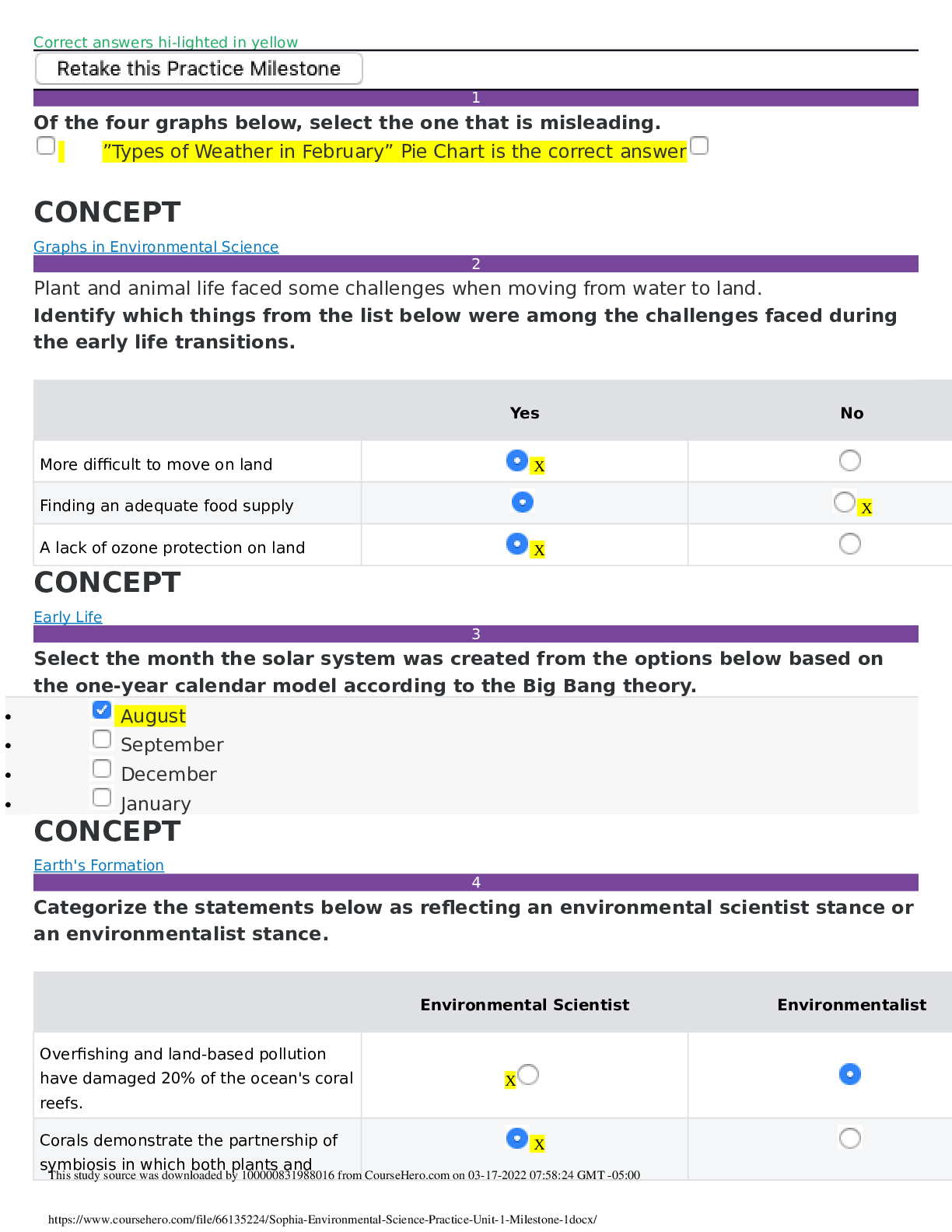
Reviews( 0 )
Document information
Connected school, study & course
About the document
Uploaded On
Oct 09, 2020
Number of pages
7
Written in
Additional information
This document has been written for:
Uploaded
Oct 09, 2020
Downloads
0
Views
154

